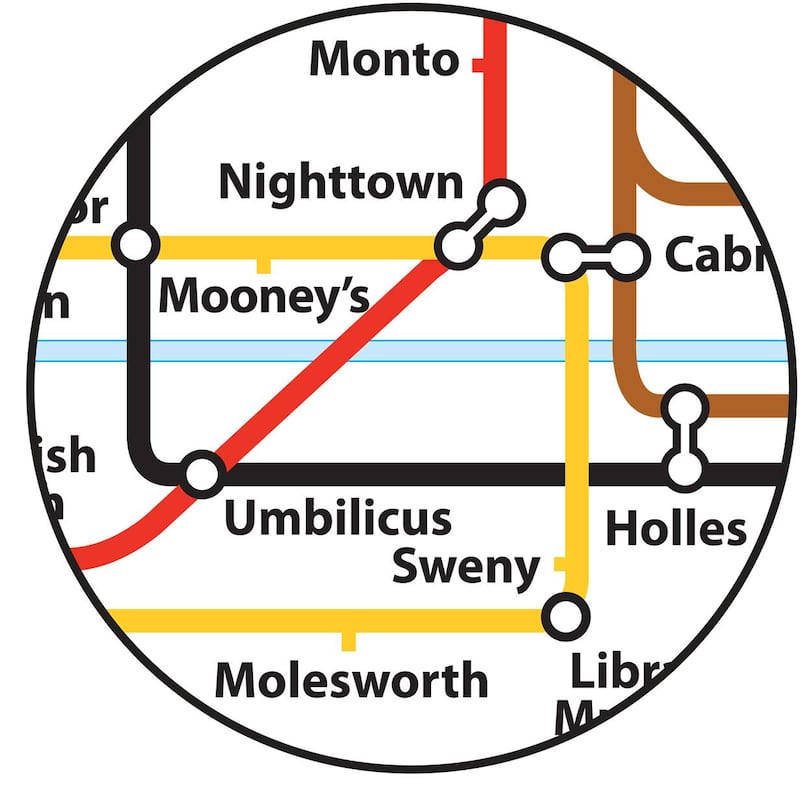While he was holed up inside during the snow a few months ago, Senan Molony came up with a cunning plan, born of boredom. Among the more arcane side interests of the Daily Mail's political editor is James Joyce.
“It’s a conceit,” Molony says of the Hibernian Metropolis, a Dublin city map of James Joyce’s Ulysses, done in the style of another classic, the Tube map. “The capital has long conceived a metro, but here is humoured the full scheme in 100 stations.”
In order to actualise his deliciously ticklesome idea, he roped in his friend, the artist and designer Conor Gallagher. Molony points out "Joyce adumbrated [what a fabulous word: to represent in outline or foreshadow] the busy work of the city's tram lines in Ulysses", and that Leopold Bloom is obsessed with logistics: how to transport livestock quickly to the cattleboat in Dublin, and the pipework to get Wicklow water to his kitchen tap.
Gallagher designed the map in the style of Harry Beck's 1931 classic London Underground map, creating a sort of sub-version of the Hibernian Metropolis (mentioned in the Aeolus episode in Ulysses), which is described as devised "via the peregrination of characters" in the novel.
Joyce’s novel seems highly suitable for the mapping treatment: Aside from Bloom’s own journey in the novel, Fr Conmee wanders off northeast from the Jesuit community near Belvedere, and the lord lieutenant leaves Viceregal Lodge and heads down the north quays. Joyce’s interest in the movement of people makes for an intricate web.
Stream of consciousness
Using these wanderings, the stations on this alternative map of Dublin pick up on the cross-currents of Joyce's stream of consciousness. Speaking of which, the map features Joyce's Anna Livia across the horizontal (in the style of the Thames in Beck's) with a tributary or stream – Consciousness – feeding into it.
So the London Underground’s Circle line becomes the Circe line “after the beguiling sorceress of Homer’s Odyssey and Nighttown, and Dollymount becomes Mollydount, the last chance for her to get off before she “gets off” with Bloom, sharing seedcake on the hill of Howth,” says Molony. Another gag is Kidney Parade, “replacing Sydney in the pantheon of Irish rail placenames by honouring Bloom’s propensity to consume inner organs of beasts and fowl. Fans of the novel will also understand the change of Booterstown to ‘Bootgertstown’, honouring the lame Gertie McDowell who hobbled her boots by the seashore here.”

Bang in the middle of the map is Umbilicus (a belly button echoing Joyce's navel references) and pubs have their own stops – Barney Kiernan (from the Cyclops episode), and Dunphy's Corner. Another station, Saltman, near the house in The Dead on Usher's Island, reflects emerging evidence that Albert Altman (or "Altman the Saltman" ) was a model for Bloom's character.
The map stretches beyond the novel, to include Dolphin’s Barnacle, and also some Finnegans Wake references, with stops such as Feenix (the park), and the Wellingdone (monument) on the same line.
Credible but playful
Gallagher’s challenge was designing a credible, if playful, map while being faithful to Beck’s Underground. “Joyce talked about being able to be able to travel around the city reading Ulysses, and you could possibly get round Dublin in the same way with this map.”
His usual work is abstract landscapes (he has a piece in the RHA gallery at the moment; conorgallagher.com) but he's also a graphic designer (eyecondesign.ie). He likes projects with a sense of humour and enjoyed how the map picks up on Joyce playing with language, while "adapting and continuing it, in its own way".
Molony often hosts "esoteric interpretations" of Joycean themes for Bloomsday, and this year's talk is Droolysses, about drink in Ulysses (appropriately, in the Leeson Lounge at 9pm, June 16th). Gallagher's main Joycean connection is through his sister Darina Gallagher, who performs, with Sinéad Murphy, Joycean parlour songs and bawdy ballads during the Bloomsday Festival (including at lunchtime on June 16th, at Dublin's Mansion House, free).
“People seem to like the map,” says Molony. And for some cognoscenti “it’s a confirmation to other people of what they know”. Gallagher is tickled that people have suggested “Liberator” would be a good name – in real life too – for a station or stop on O’Connell Street, near the monument.
Erudite joke
Joyce experts will get all the references, and the rest of us on nodding acquaintance can chuckle at the erudite cartographical joke.
There are plans for a teatowel of the map, and they’re trying to source a mug large enough to take the image.
“It’s a pure lark, a bit of crack,” says Molony. Joyce would have loved the idea of the metro, he reckons: “We’ve been discussing it for decades, like an urban version of draining the Shannon. He’d have a great laugh at that.” So they included a broken red line indicating a line under construction to New Bloomusalem, though “like the airport metro, it’s never going to happen in our lifetime”.
Joyce would have liked the entire map, no doubt, enjoying the “notions of upperosity” (says Molony, borrowing an O’Casey-ism) of our own underground.
- The Hibernian Metropolis, A3 poster print on 300gsm paper (€25), is in "all good Joycean outlets" (including Sweny's Chemist, the James Joyce Centre and Irish Craft Siopa in the Chocolate Factory in Dublin, and the Yeats Building in Sligo) and on etsy.com













